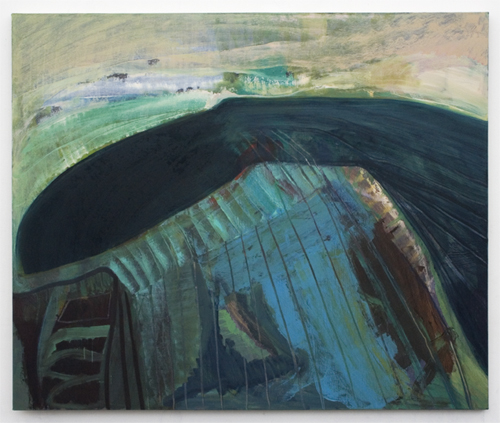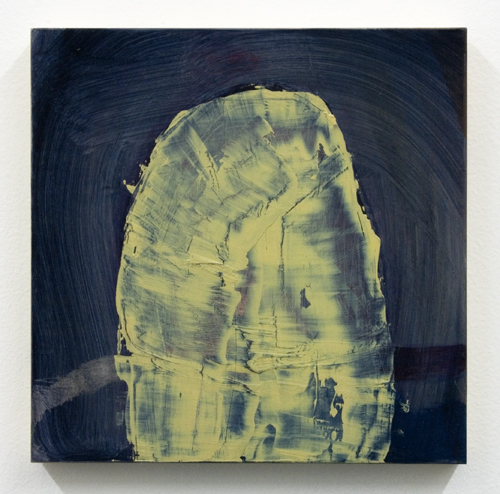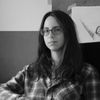It surprises me that in today's art world, over a century since the traditions of realism were first challenged, one can still sense a friction between two camps: painters working un-ironically within a realist tradition, and those working in a reactionary paradigm. It's a gulf that's been forged throughout history; for as long as the boundaries of painting have been expanding, academic and avant garde painters alike have huddled defensively around their distinctive artistic principals, feeling them threatened by the other side. In my own experience, as a graduate of a conceptual BFA program and as a student of Odd Nerdrum's more traditional school, I've witnessed insularity and prejudice at both ends.
It's refreshing to see a painter like Lauren Gidwitz, whose trajectory reflects a more open approach to painting. Looking at her work, abstraction and traditional realism begin to feel less like mutually exclusive camps, and more like points on a spectrum--a spectrum on which an artist can slide simply by consequence of searching for her clearest voice.

Night of the Freeze, oil on linen, 19 x 15
I first met Gidwitz in 2009, in the student quarters of Odd Nerdrum's pastoral headquarters in Norway. I had a habit of identifying the other students--some who I've never met in person--through their self portraits, which I would see hanging in the house, or in the books, catalogues, and online images we constantly passed around. I knew Gidwitz then by her self portrait, Night of the Freeze. Despite how different her work looks today, I can still identify Gidwitz by the formal qualities in the painting. Even with a 4 color palette, the left side of the hair and the index finger tip reveal her strength as a colorist. Her seductive playfulness in paint handling also emerges in the hair, and in the shadows on the chest. Gidwitz's other paintings from that period, such as Emergence and Bee Sting, more directly foreshadow the ambiguity of her current work. Their cropped compositions of the human figure loosen the premise of realism, freeing her to experiment more with color and texture and leading her away from a world of pure illusion. These early paintings, from 2009 to 2011, mark the beginning of a major transition which led Gidwitz, formally, into new territory, though the core of her artistic identity, traced in her essential treatment of paint, has wavered little.

Tumbledneath, oil on linen, 60 x 72
When I ask Gidwitz about the content of her work, I learn that memory and the complexity of experience have remained major themes throughout her trajectory. I ask her about Tumbledneath, a recent painting that has always attracted me, and which I've always called abstract. But Gidwitz explains to me how Tumbledneath is representational of a real experience from her life--it's a painting of a specific place and time. But, I prod, is it representational in the sense that it's supposed to look like something? "Yes," she says. "It's just not obvious." She goes on to explain how the painting shows 4 different visual points of view of a single place in a single moment. I begin to see the deck of a boat, a bowed horizon, a tiny wave. Tumbledneath represents the complexity of an experience literally, by depicting its aspect from all possible angles. The painting also reads, perhaps more immediately, as a non-literal, psychological environment. Abstract and representational languages both serve as potential frameworks for entering into Tumbledneath's layered meaning.
Gidwitz talks freely about the deliberate choices she made concerning the major transition in her work. While she was in graduate school, at the Pennsylvania Academy of Fine Arts, she made a concerted effort to expand her vocabulary through paint, to build her knowledge of color and manners of application. She wanted to steer her paintings away from telling and more toward suggesting possibilities to the viewer, and she wanted to somehow dig deeper into the re-creation of experience through painting. The ensuing pursuit of these goals happened to lead her to where she is now, but Gidwitz will tell you that she did not decide to become a more abstract painter.

Unified, oil on panel, 8 x 8
An invisible line encompasses the total output of any artist, revealing a shape as unique as a fingerprint. That line may be ever in flux, but it allows us to talk about an artist's work, to situate it in history, to compare it to other artists' shapes. Some artists work best by erecting the limits first and bouncing against them, and sometimes the lines simply fall around work that's driven in other ways. Irregardless, it shows when the boundary has evolved out of an artist's particular creative needs, or when the fence posts of other groups or movements have determined its evolution.
In my experience, the polarization of painting in today's art world encourages painters to narrow their expressive range to one pre-fabricated set of boundaries or the other. Artists like Lauren Gidwitz present a more progressive perspective that includes all of painting on a single spectrum. After all, the realist tradition has been vital to the triumphs of abstract painting throughout history. Scores of painters, including Mondrian, Picasso, and Pollock, have used their classical training as a launching pad to arrive at new languages. Conversely, realist painting is at its core an abstraction of the 3 dimensional world onto a flat plane--a translation that certainly requires, at times, non-observation based decision making. Gidwitz's approach makes available to the painter a greater range of tools and renders existing boundaries inconsequential to the natural fruition of one's own work.
A more complete selection of Lauren Gidwitz's work can be found at www.laurengidwitz.com.
6 of her paintings, including Tumbledneath, are currently on view through December at the Memorial Sloan-Kettering Cancer Center, at 205 East 64th Street, New York, NY.
All images courtesy of the artist.
